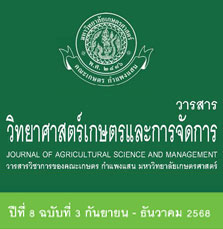Indicators for Assessing the Sweetness of Coconut Water
Keywords:
soluble solids content, titratable acidity, BrimA, quality indexAbstract
Ensuring the desired sweetness of coconut water is crucial for consumer satisfaction. In this study, a total of 290 young aromatic coconuts were analyzed for soluble solids content (SSC), titratable acidity (TA), flesh thickness (FT), and sensory qualities. We also introduced the concept of BrimA, representing the difference between SSC and TA as an indicator of the flavor of coconut water. Our correlation analysis revealed that sweetness in coconut water was significantly correlated with BrimA (r=0.70) followed by SSC/TA (r = 0.54), TA (r = -0.51) and SSC (r = 0.41). Stepwise discriminant analysis (SDA) was performed to develop a model with optimally selected classifying variables. The overall classification accuracy of the SDA model for predicting sweetness was 70.78 %. Regarding BrimA and TA parameters as the greatest significant contributors of this coconut sweetness, the 'not sweet' samples were correctly predicted at 61%, while the 'sweet' samples were correctly predicted at 78 %.
References
A.O.A.C. 1990. Official Methods of Analysis. 15th Edition, Association of Official Analytical Chemist, Washington DC.
Assa, R.R., A. Prades, A.G. Konan, J. Nemlin and J.-L. Konan. 2013. Sensory evaluation and sugars contents of coconut (Cocos nucifera) water during nuts ripening. African Journal of Food Science 7: 186–192. https://doi.org/10.5897/AJFS2012.0601.
Cheepsomsong, T., P. Sangwanangkul, A. Puttipipatkajorn, A. Terdwongworakul, A. Puttipipatkajorn, S. Kulmutiwat and A. Phuangsombut. 2023. Multi-parameter index for durian maturity and its prediction using miniature near infrared spectrometer. Postharvest Biology and Technology 205: 112487. https://doi.org/10.1016/j.postharvbio.2023.112487.
Cruz-Castillo, J., S. Ganeshanandam, B. MacKay, G. Lawes, C. Lawoko and D. Woolley. 1994. Applications of canonical discriminant analysis in horticultural research. HortScience 29: 1115–1119. https://doi.org/10.21273/HORTSCI.29.10.1115.
Da Conceicao Neta, E.R., S.D. Johanningsmeier and R.F. McFeeters. 2007. The chemistry and physiology of sour taste a review. Journal of Food Science 72: R33–R38. https://doi.org/10.1111/j.1750-3841.2007.00282.x.
da Silva Ferreira, M. V., I.A. de Moraes, R.V.L. Passos, D.F. Barbin and J.L. Barbosa Jr. 2023. Determination of pitaya quality using portable NIR spectroscopy and innovative low-cost electronic nose. Scientia Horticulturae 310: 111784. https://doi.org/10.1016/j.scienta.2022.111784.
Fawole, O.A. and U.L. Opara. 2013a. Changes in physical properties, chemical and elemental composition and antioxidant capacity of pomegranate (cv. Ruby) fruit at five maturity stages. Scientia Horticulturae 150: 37–46. https://doi.org/10.1016/j.scienta.2012.10.026.
Fawole, O.A. and U.L. Opara. 2013b. Harvest discrimination of pomegranate fruit: postharvest quality changes and relationships between instrumental and sensory attributes during shelf life. Journal of Food Science 78: S1264–S1272. https://doi.org/10.1111/1750-3841.12176.
Funsueb, S., C. Thanavanich, P. Theanjumpol and S. Kittiwachana. 2023. Development of new fruit quality indices through aggregation of fruit quality parameters and their predictions using near-infrared spectroscopy. Postharvest Biology and Technology 204: 112438. https://doi.org/10.1016/j.postharvbio.2023.112438.
Jackson, J.C., A. Gordon, G. Wizzard, K. McCook and R. Rolle. 2004. Changes in chemical composition of coconut (Cocos nucifera) water during maturation of the fruit. Journal of the Science of Food and Agriculture 84: 1049–1052. https://doi.org/10.1002/jsfa.1783.
Jaroonchon, N., K. Krisanapook and W. Imsabai. 2017. The development of 2 acetyl-1-pyrroline (2-AP) in Thai aromatic coconut. Songklanakarin Journal of Science and Technology 39: 179–183.
Jordan, R.B., R.J. Seelye and V.A. McGlone. 2001. A sensory-based alternative to brix/acid ratio. Food Technology 55: 36–44.
Obenland, D., S. Collin, B. Mackey, J. Sievert, K. Fjeld and M.L. Arpaia. 2009. Determinants of flavor acceptability during the maturation of navel oranges. Postharvest Biology and Technology 52: 156–163. https://doi.org/10.1016/j.postharvbio.2009.01.005.
Office of the Permanent Secretary Ministry of Commerce. 2023. Export of Thailand classified by commodity HS code 08011910: Young coconut. (Online): Available Source:https://tradereport.moc.go.th/Report/Default.aspx?Report=HarmonizeCommodity&Lang=Eng&ImExType=2&Option=2&hscode=08011910 (June 14, 2024).
Nikhontha, K., K. Krisanapook and W. Imsabai. 2019. Fruit growth, endocarp lignification, and boron and calcium concentrations in Nam Hom (aromatic) coconut during fruit development. Journal of the International Society for Southeast Asian Agricultural Sciences 25: 21–31.
Pissard, A., E.J.N. Marques, P. Dardenne, M. Lateur, C. Pasquini, M.F Pimentel, J.A.F. Pierna and V. Baeten. 2021. Evaluation of a handheld ultra-compact NIR spectrometer for rapid and non-destructive determination of apple fruit quality. Postharvest Biology and Technology 172: 111375. https://doi.org/10.1016/j.postharvbio.2020.111375.
R Core Team. 2021. R: A language and environment for statistical computing. R Foundation for Statistical Computing. https://www.R-project.org/.
Saftner, R., J. Polashock, M. Ehlenfeldt and B. Vinyard. 2008. Instrumental and sensory quality characteristics of blueberry fruit from twelve cultivars. Postharvest Biology and Technology 49: 19–26. https://doi.org/10.1016/j.postharvbio.2008.01.008.
Schwieterman, M.L., T.A. Colquhoun, E.A. Jaworski, L.M. Bartoshuk, J.L. Gilbert, D.M. Tieman, A.Z. Odabasi, H.R. Moskowitz, K.M. Folta, H.J. Klee, C.A. Sims, V.M. Whitaker and D.G. Clark. 2014. Strawberry flavor: Diverse chemical compositions, a seasonal influence, and effects on sensory perception. PLoS ONE 9(2): e88446. https://doi.org/10.1371/journal.pone.0088446
Tan, T.C., L.H. Cheng, R. Bhat, G. Rusul and A.M. Easa. 2014. Composition, physicochemical properties and thermal inactivation kinetics of polyphenol oxidase and peroxidase from coconut (Cocos nucifera) water obtained from immature, mature and overly-mature coconut. Food Chemistry 142: 121–128. https://doi.org/10.1016/j.foodchem.2013.07.040.
Terdwongworakul, A., S. Chaiyapong, B. Jarimopas and W. Meeklangsaen. 2009. Physical properties of fresh young Thai coconut for maturity sorting. Biosystems Engineering 103: 208–216. https://doi.org/10.1016/j.biosystemseng.2009.03.006.
Vásquez-Caicedo, A.L., P. Sruamsiri, R. Carle and S. Neidhart. 2005. Accumulation of all-trans-β-carotene and its 9-cis and 13-cis stereoisomers during postharvest ripening of nine Thai mango cultivars. Journal of Agricultural and Food Chemistry 53: 4827–4835. https://doi/10.1021/jf048168h.






